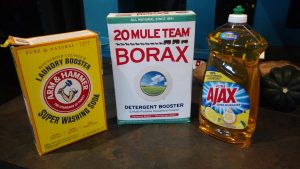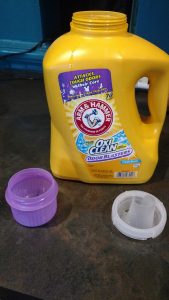I love this butter and wanted to share it with you. It can be used on any unvarnished wood to restore its luster and create a barrier to protect the wood from water damage. I use it on wood cutting boards, spoons, salad bowls, rolling pins, wood mortars and pestles, and the list goes on. And bonus – it’s really simple to make!
Ingredients:
- 16 oz bottle of fractionated coconut oil (you can substitute food grade mineral oil if you choose)
- 4 oz beeswax – more or less depending on preference
- (optional: a few drops of lemon essential oil – NOT fragrance oil)
Directions:
Make sure the coconut oil is fractionated or the mineral oil is food grade, as those are the only two oils that are safe to use on cutting boards and wooden serveware.
This is exactly the same technique as making a salve. Dump the fractionated coconut oil in a double boiler – I use a large Pyrex measuring cup over a pot of boiling water. Heat the oil gently. Once the oil is a tish above warm, dump in the 4 oz of beeswax. Stir. Continue to heat, stirring occasionally, until the beeswax is melted. Test the butter by dunking a room temperature stainless steel spoon into the mix and quickly taking it away from the stove. Allow the butter to cool on the spoon for a minute, then test its Goldilocks Factor with your finger. If it’s too mushy for your taste, add more beeswax. If it’s too hard, add more fractionated oil. If it’s just right, remove it from heat – eeeh but don’t eat it 😉
If you’re using the lemon essential oil add it now and stir well.
Then, pour the entire shebang into a vessel of your choice. As long as it has a lid and a wide mouth, it works. Keep the lid off until the butter is completely cool, then cap tightly and store in a cool, dark area – a dungeon, perhaps.
Before using this, you’ll want to coat your wood with whatever oil you picked – fractionated coconut or food grade mineral oil – and allow the oil to soak into the grains overnight. Then, wipe the wood down to remove any oil that wasn’t absorbed. Pat a bit of the butter on a clean cotton cloth and rub a thin layer into the wood. Buff it out and you’re done!

